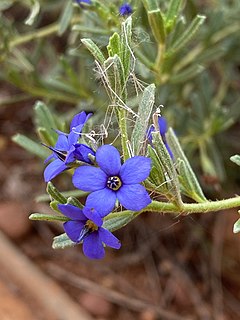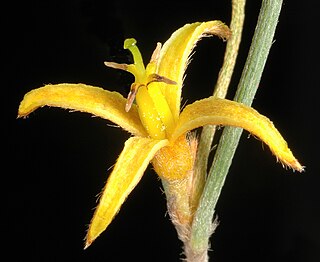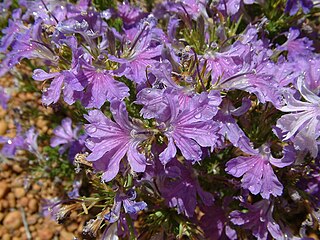
Stylidium laricifolium, commonly known as giant trigger-plant, larch-leaf or tree triggerplant, or is a species of flowering plant in the family Stylidiaceae and is endemic to eastern Australia. It is a perennial subshrub with many linear leaves crowded along its few stems, the flowers white to pale pink and arranged in a single main panicle and smaller racemes.

Chrysocephalum, known by the common name everlastings for their long life as cut flowers, is a genus of flowering plants in the family Asteraceae. There are nine species, all of which were formerly classified under other genera.

Hovea trisperma, commonly known as common hovea, it is a flowering plant in the family Fabaceae. It is a small straggling shrub with purple-blue flowers and is endemic to Western Australia.

Grevillea crithmifolia is a species of flowering plant in the family Proteaceae and is endemic to the south-west of Western Australia. It is a dense shrub with linear leaves, divided leaves with narrowly oblong lobes, or both, and clusters of pale pink to creamy-white flowers.
Patersonia maxwellii is a species of flowering plant in the iris family Iridaceae and is endemic to the south of Western Australia. It is a tufted, rhizome-forming perennial herb with linear leaves and violet tepals.

Chrysocephalum semipapposum, commonly known as clustered everlasting is a perennial shrub native to Australia. Clustered everlasting belongs to the family Asteraceae. C. semipapposum produces terminal flowers heads in clusters, mainly between spring and early summer with silver-grey appearing stems and branches. It grows up to 40cm high and 60 cm high, although there have been some varieties which can grow up to 1 m. C. semipapposum is often confused with Chrysocephalum apiculatum or 'yellow buttons', due to their similar appearances. C. semipapposum has 4 different subspecies, however they lack distinctive qualities and are often hard to identify. C. semipapposum is endemic to Australia and can be found in multiple states, most notably within Victoria. The plant is found in a variety of habitats including dry rocky regions. Clustered everlasting often grows sparsely and is rarely found in abundance and can be mistaken for a weed. Clustered everlasting has many uses, including as a source of nectar for butterflies, cut flowers or as an addition to a garden.

Dillwynia cinerascens, commonly known as grey parrot-pea, is a species of flowering plant in the family Fabaceae and is endemic to south-eastern Australia. It is an erect to low-lying shrub with linear or thread-like leaves and orange or yellow flowers.

Halgania cyanea, commonly known as rough halgania, is a species of flowering plant in the family Boraginaceae. It is a small perennial shrub with dull green leaves, bright blue flowers and is endemic to Australia.

Goodenia hederacea, commonly known as forest goodenia or ivy goodenia, is a species of flowering plant that is endemic to eastern Australia. It is a prostrate to ascending, perennial herb with linear to elliptic or round leaves, and racemes of yellow flowers.

Persoonia angustiflora is a species of flowering plant in the family Proteaceae and is endemic to the south-west of Western Australia. It is an erect shrub with hairy branches and leaves, linear, more or less cylindrical leaves and yellow or greenish yellow flowers arranged singly or in groups of up to four.

Grevillea coccinea is a species of flowering plant in the family Proteaceae and is endemic to the south of Western Australia. It is a low-lying or sprawling shrub with narrowly wedge-shaped to linear leaves and white, cream-coloured, and red or yellow flowers.

Goodenia arthrotricha is a species of flowering plant in the family Goodeniaceae and endemic to south-western Western Australia. It is an erect perennial, herb with linear to lance-shaped leaves with the narrower end towards the base, racemes of blue flowers with linear bracteoles at the base, and oval fruit.

Goodenia coerulea is a species of flowering plant in the family Goodeniaceae and is endemic to the south-west of Western Australia. It is an erect, perennial shrub or biennial herb shrub with linear leaves at the base of the plant, sometimes with a few teeth on the edges, racemes of blue flowers and oval fruit.

Senecio linearifolius, commonly known as fireweed groundsel, is a species of flowering plant in the family Asteraceae. It is a small shrub with variable leaves, numerous heads of yellow flowers and grows in Tasmania, New South Wales and Victoria.

Goodenia scapigera, commonly known as white goodenia, is a species of flowering plant in the family Goodeniaceae and is endemic to the south-west of Western Australia. It is an erect, perennial herb or shrub with linear to narrow egg-shaped leaves clustered near the ends of the stems, and thyrses of white flowers with purplish spots.

Dampiera rosmarinifolia, commonly known as rosemary dampiera, is a flowering plant in the family Goodeniaceae.It is a perennial subshrub with linear leaves, mauve or purple flowers borne in leaf axils.

Chrysocephalum baxteri, known by the common name fringed everlasting is a perennial herb native to southern Australia. It is a member of the Asteraceae, the daisy family. Found in low heath country and sclerophyll forest. A small plant, 10 to 40 cm high with many stems. Leaves are linear in shape, 4 to 30 mm long, 0.5 to 2.5 mm wide. Both leaf surfaces are a felty grey/green. White flowers mostly form in spring and summer.

Vittadinia gracilis, known by the common name woolly New Holland daisy, is a perennial shrub mostly seen in the southern parts of Australia. A member of the Asteraceae, the daisy family. A small plant, 10 to 40 cm high with erect stems. Leaves are flat or folded on the centre, linear to narrow lanceolate or spathulate, 10 to 40 mm long, 2 to 7 mm wide. Stems form annually from a woody base with a coating of dense, fine white hairs, less often seen on the leaves. The specific epithet gracilis is derived from the Latin adjective gracilis.
Patersonia argyrea is a species of plant in the iris family Iridaceae and is endemic to Western Australia. It is a tufted perennial herb with linear, sword-shaped leaves and violet tepals.

Lechenaultia magnifica, commonly known as magnificent leschenaultia, is a species of flowering plant in the family Goodeniaceae and is endemic to the south-west of Western Australia. It is an erect, perennial herb or subshrub with crowded, linear to narrowly lance-shaped leaves, and pink to mauve or purple flowers.


















